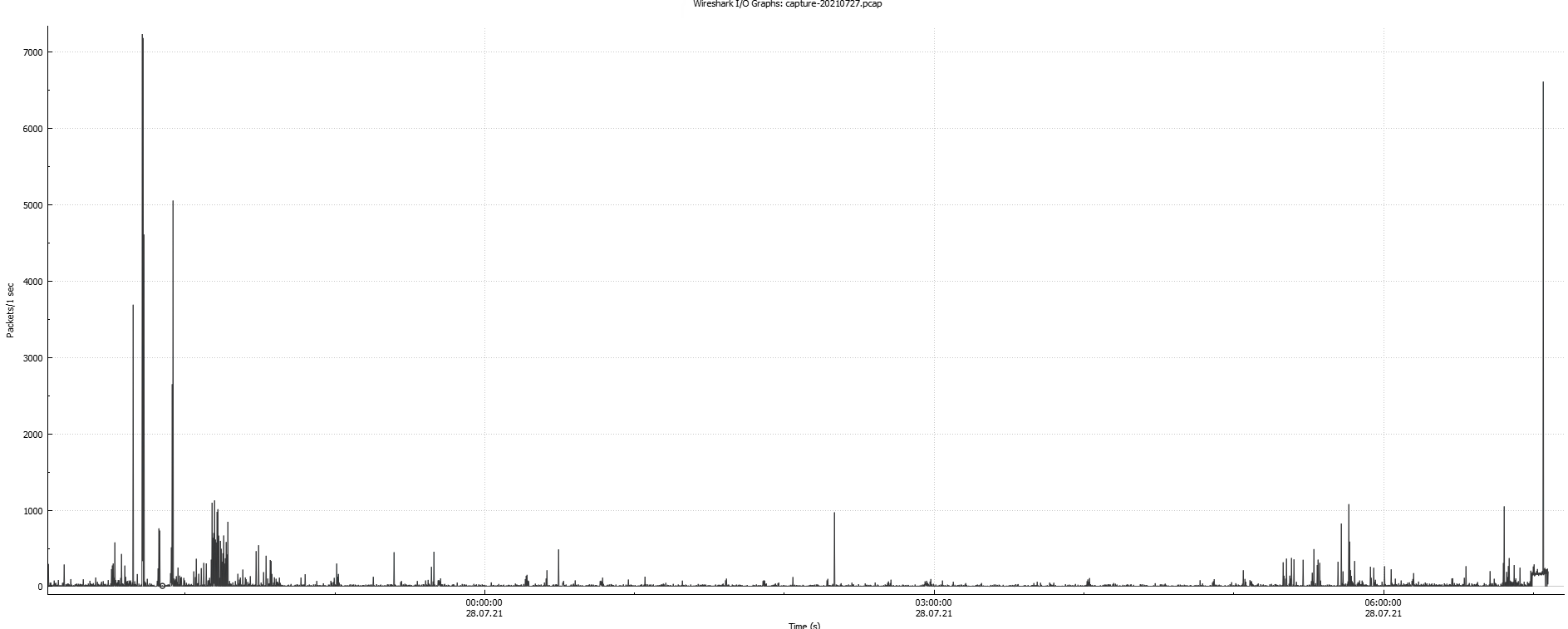Marek,
This is great. It is interesting that upstream is only 3% of the total frame count.
Can you check in your setup what is reported as packet length? There are about 1.6K packets with the length between 60 and 63 bytes. On the large side, there are 180 packets with sizes above jumbo frame, from 11270 to the largest 32123 bytes. Are these IP packet lengths? Do you have L2 frame lengths in the pcap?
To find out the interval *between* frames, frame lengths are needed in addition to timestamps. Also, I don’t remember what is the captured timestamp in wireshark – is this the beginning of a packet or the end after FCS is checked? Do you know?
Thanks,
Glen
From: mxhajduczenia@xxxxxxxxx <mxhajduczenia@xxxxxxxxx>
Sent: Wednesday, July 28, 2021 6:33 AM
To: 'Glen Kramer' <glen.kramer@xxxxxxxxxxxx>
Cc: STDS-1904-4-TF@xxxxxxxxxxxxxxxxx
Subject: RE: [1904.4 TF] Power saving estimates from 802.3av
Glen,
Here is the result for last night (9pm – 7am) with 1 second interval. Local time is used for reference.

I sanitized the data and it is available in Excel format for offline analysis: https://drive.google.com/file/d/1lyi2UPZh7xcqdUJyul-mYRX3YV2An9FB/view?usp=sharing. The file is too big to share directly via email so I am sharing it via GDrive. I have the raw pcap file as well, should it be needed. The capture was done at the input interface into my edge firewall, so it contains all Internet traffic before anything gets filtered.
Marek
From: Glen Kramer <glen.kramer@xxxxxxxxxxxx>
Sent: Tuesday, July 27, 2021 8:21 PM
To: Marek Hajduczenia <mxhajduczenia@xxxxxxxxx>
Cc: STDS-1904-4-TF@xxxxxxxxxxxxxxxxx
Subject: Re: [1904.4 TF] Power saving estimates from 802.3av
Marek,
IOT or not is not so important. What is interesting is what the traffic looks like when nobody is actively using the Internet, like in the middle of the night.
(Sent from Samsung Galaxy far, far away, where typos are normal)
On Tue, Jul 27, 2021, 6:04 PM Marek Hajduczenia <mxhajduczenia@xxxxxxxxx> wrote:
Glen,
I have separate VLANs for different traffic types, so I should be able to separate IOT from any other traffic types.
I should be able to provide a full resolution graph of packet size vs arrival times, no issues there.
Marek
On Tue, Jul 27, 2021 at 6:42 PM Glen Kramer <glen.kramer@xxxxxxxxxxxx> wrote:
A few more relevant presentations:
https://www.ieee802.org/3/av/public/2008_11/3av_0811_hajduczenia_2.pdf
https://www.ieee802.org/3/av/public/2008_11/3av_0811_hirth_2.pdf
Marek,
Thank you for the offer to capture 24hr data. It would be most interesting to see a distribution of time between successive frames (separately for upstream/downstream). I think just the timestamps and packet sizes are all we need.
Glen
From: Marek Hajduczenia <mxhajduczenia@xxxxxxxxx>
Sent: Tuesday, July 27, 2021 4:49 PM
To: STDS-1904-4-TF@xxxxxxxxxxxxxxxxx
Subject: [1904.4 TF] Power saving estimates from 802.3av
These are two presentations that have numbers in them:
- https://www.ieee802.org/3/av/public/2008_09/3av_0809_mandin_4.pdf
- https://www.ieee802.org/3/av/public/2008_09/3av_0809_otaka_1.pdf
Regards
Marek
To unsubscribe from the STDS-1904-4-TF list, click the following link: https://listserv.ieee.org/cgi-bin/wa?SUBED1=STDS-1904-4-TF&A=1
To unsubscribe from the STDS-1904-4-TF list, click the following link: https://listserv.ieee.org/cgi-bin/wa?SUBED1=STDS-1904-4-TF&A=1